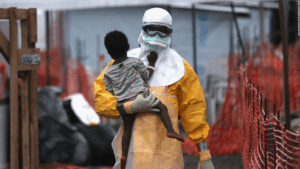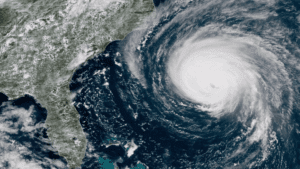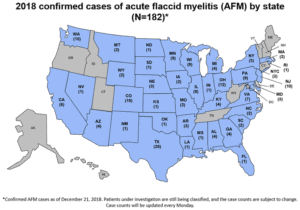From the reemergence of vaccine-preventable diseases to Acute Flaccid Myelitis, we’re bringing you a roundup of the major global health stories of 2018.
Reemergence of Measles

Measles is a highly contagious, viral illness. During the 1950s, in stark contrast to the present day, almost every American was affected by the measles, with nearly all children suffering a bout of the measles before their 15th birthday. In 1963, a vaccine was introduced and administered globally and by the year 2000, Measles was officially eradicated from the United States. However, nearly 20 years after eradication, there has been a global comeback of the deadly disease. Since 2017, the Americas, Eastern Mediterranean, and Europe all experienced a 30 percent increase in the number of reported cases. Cases in Europe reached a record high in August 2018. It is estimated that the illness claimed 110,000 lives in 2017 alone.
Measles is spread through the air via droplets in coughs and sneezes. Symptoms include:
- Cold-like symptoms
- High fever
- Loss of appetite
- Muscle aches
- Red, watery eyes
- Greyish spots in the mouth
- Red, raised spots that may merge together becoming blotchy. These spots typically start at the hairline ad spread down over the head, neck, and rest of the body
Unfortunately, there is no cure for measles. The WHO points to gaps in vaccination coverage for the reemergence of the disease and recommends that citizens get vaccinated. In the United States, as of December 1, 2018, 292 cases have been confirmed in 26 states. In coordination with WHO recommendations, VIGILINT recommends that you get vaccinated if you have not already done so.
Ebola

On August 1, 2018, the World Health Organization (WHO) declared a new outbreak of Ebola in the Democratic Republic of Congo (DRC). This declaration marks the 10th outbreak of the virus in the country since 1976. The total number of cases so far has reached 585. Of these, 537 have been confirmed and 48 are probable. There have been 356 total deaths. Despite rapid response from medical officials and global non-profit networks like the Red Cross, the number of cases continues to rise. Compared to prior outbreaks, healthcare responders have never had so many tools at their disposal to fight the deadly virus. To date, 53,000 Ebola vaccines have been administered to outbreak hotspots. In addition, authorities in the DRC recently approved clinical trials for four experimental Ebola treatments.
Despite trial treatment options and widespread vaccination efforts, the 2018 Ebola outbreak has been particularly hard to contain because the virus is spreading in active war zones. The 2018 outbreak began in the North Kivu and Ituri provinces, and both provinces continuously face the threat of violence from multiple rebel and militia groups. These groups regularly interrupt the work of local and international aid workers by threatening and injuring staff. After multiple attacks from these groups in early October, the U.S. State Department pulled American aid workers out of the DRC due to safety concerns. Evidence points to a surge in reported cases without the US on-site effort. Without the aid from United States aid workers, one can only suspect that the outbreak will likely get worse before it gets better.
Influenza

The 2017-2018 flu season was exceptionally catastrophic for a number of reasons ranging from uncontrollable environmental factors to vaccine efficacy issues. The season ended and was declared the worst since the 2009 Swine Flu Pandemic. It is estimated that the virus took up to 80,000 lives. The 2018-2019 flu season is now in full swing, and the CDC announced that although more adults have received the vaccine compared to last year (45% compared to 39% this time last year) the vaccination rates are still not high enough.
To protect yourself, VIGILINT has the following tips:
- Get vaccinated! Though vaccine efficacy has been an issue in the past, so far this season, there is strong evidence that the flu vaccine will be beneficial in preventing the flu and lessening the severity of those who do become ill. Everyone over the age of 6 months who is not allergic to one of the vaccine’s components is able to receive the flu shot unless otherwise instructed by a physician. Flu shots are typically available at doctor’s offices, clinics, health departments, pharmacies, and college health centers.
- Be proactive. Take preemptive actions in preventing the spread of germs. Avoid contact with sick people, wash your hands often, and limit contact with others if you are sick.
- Take antivirals if prescribed. If caught early enough, physicians may prescribe antiviral treatments to shorten the illness or make symptoms more mild. If you are prescribed an antiviral, finish the entire course even if you begin to feel better.
Every year, the CDC monitors influenza activity and posts weekly reports. To keep up with the spread of the virus on your area, click here.
Hurricane Florence

2017 saw the devastating effects of Hurricane Harvey and Hurricane Maria, and this year, in a merciless path of destruction, Hurricane Florence killed 51, trapped hundreds, and made parts of North and South Carolina impassable with historic flooding. In addition to the usual challenges that can be expected with floodwaters, the east coast faced several health and safety concerns following the storm. These health and safety concerns included:
- Hog waste and water contamination. North Carolina is home to 2,100 hog farms and close to 8.9 million hogs. Hog lagoons are human-made, open-air pits that store the animal waste that is produced on the farms. The waste is stored and then eventually applied to nearby fields as fertilizer for crops. Though it is rare for lagoons to overflow, the aftermath of Florence led to at least 27 lagoon overtops throughout the state. In addition to the usual concerns regarding exposure to animal waste, there are some concerns over the possibility of the bacteria within the lagoons being antibiotic resistant because the farming industry uses antibiotics to aid in animal growth. According to the CDC, antibiotic resistance is dangerous because it can cause illnesses that were once easily treatable with antibiotics to become untreatable, leading to dangerous infections. Antibiotic-resistant bacteria are often more difficult to kill and more expensive to treat. In some cases, the antibiotic-resistant infections can lead to serious disability or even death. Cases of methicillin resistant staphylococcus aureus (MRSA) have been previously found in North Carolina residents living near industrial hog farms.
- Mosquitoes. In North Carolina alone, Florence dumped upwards of 30 inches of rain. The high amounts of rainfall and standing rain, plus North Carolina humidity created the perfect breeding ground for mosquitoes because eggs usually need some form of water to hatch. The mosquito-borne illnesses most often found in North Carolina are West Nile virus, Eastern Equine Encephalitis, and La Crosse encephalitis. Though these more common mosquito-borne illnesses usually do not cause symptoms, some people are at risk for flu-like symptoms such as headache, fever, chills, and vomiting. So far, no cases of dengue fever or malaria have been determined to have been acquired in North Carolina following Hurricane Florence. Mosquito-borne illnesses and bites can be prevented in two ways: personal protection and reducing the mosquito population. To fight the mosquito population, North Carolina Governor Roy Cooper ordered $4 million to be spent on mosquito control following Hurricane Florence. According to the CDC, residents in these areas should also utilize DEET (or an equivalent) and wear long-sleeves and long pants while outdoors.
- Long-term effects on mental health. Nearly three months after the storm, as recovery teams and clean-up crews have quietly packed up and moved on, residents who were heavily impacted by the storm are forced to cope with finding a new normalcy. Post-hurricane research and studies have linked the impact of exposure to a hurricane to increased symptoms of post-traumatic stress and depression. Some studies have indicated that property damage, long-term power outages, displacement, or the death of loved ones during the storm can contribute to post-storm mental-health problems. The United States Department of Health and Human Services has even addressed the risk of long-term psychological issues following Hurricane Florence. One study indicated Post-traumatic Stress Disorder (PTSD) prevalence among direct victims of natural disasters was 30 to 40% compared with a prevalence of 5% to 19% in the general population.
It is estimated that the storm caused between $38 billion and $50 billion in damage throughout North and South Carolina. These estimates put the storm within the top 10 costliest when compared to National Hurricane Center data. Long-term health impacts from the storm are still being evaluated as of this week.
Acute Flaccid Myelitis

Acute flaccid myelitis (AFM) is a rare, polio-like condition that affects the nervous system. It attacks the area of the spinal cord known as gray matter and causes muscles to become weak or paralyzed. The CDC began to closely monitor AFM in 2014 after officials saw a large increase in the number of cases in children. As of December 2018, there have been 182 confirmed cases throughout 36 states. This is a major increase from 2017 from only 35 cases.
Symptoms of AFM include:
- Dropping eyelids and trouble moving eyes
- Hard time speaking or swallowing
- Slurred speech
- Trouble breathing
- Fever and general malaise
- Stiff neck
Unfortunately, there is no cure for AFM and experts are unsure what triggers the disease or why there has been such a large increase in reports. The CDC continues to work closely with state and local health officials to monitor and investigate each AFM case in an attempt to figure these things out. In their investigation, the CDC reported that 90% of patients had a mild respiratory illness or fever consistent with a viral infection before developing AFM. Dave Thompson, the Vice President of Medical Affairs at VIGILINT was recently interviewed about the recent spike in cases. Thompson recommends that children get vaccinated and practice good hand hygiene. The interview appeared on local news.
Our Medical Operations Center will continue to monitor major global health news trends in 2019. Please subscribe to our monthly newsletter to keep up to date with our latest blogs and medical intel.
